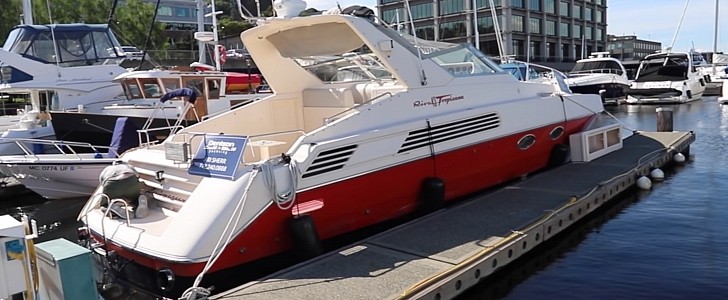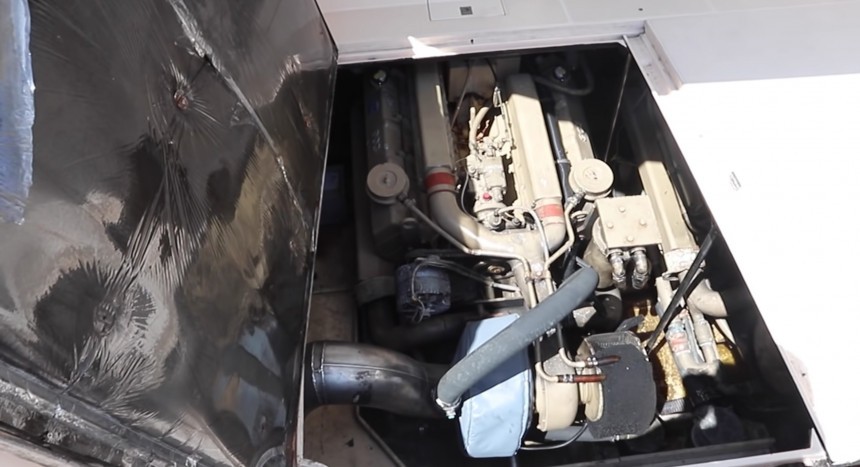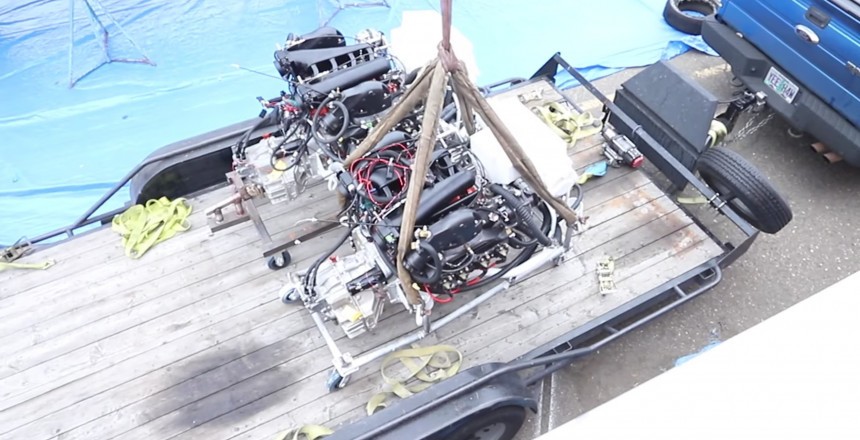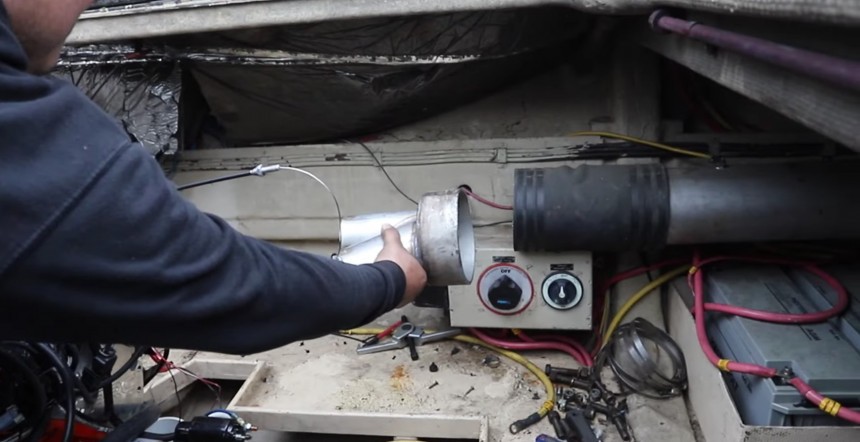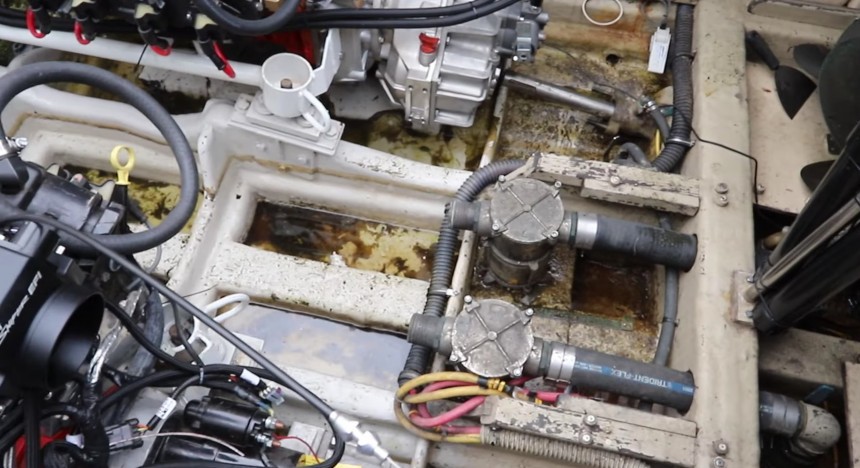Boats, just like airplanes, work on the same basic principles as an automobile. The only difference is they operate in different spaces. Still, they all run on combustion engines, even though that's rapidly shifting to more efficient sources of energy. Therefore, a boat engineer could quickly fix a problematic car engine and vice versa. However, it gets a little dicey when it comes to getting them moving in their confined spaces – experience is vital.
Chris Steinbacher of B is for Build YouTube channel has built a reputation on the platform by doing some DIY automotive magic from his home garage. He's recently been working on something different from what his regular fans are used to watching. He's installing two LSX engines in a yacht.
Before the pandemic broke out in 2020, he'd purchased a 30-year-old Italian Yacht that he'd been looking to improve over the years. Unfortunately, the engine seized while going out on a cruise.
Like any other DIY-er would have done, Chris decided to get his hands dirty and started a yacht rebuild project.
"Once we got the engine back to the shop, we started in on the teardown process and eventually found out the bad news. We had a damaged piston, we had a damaged cylinder wall, and really, unfortunately, is we had a lot of signs within our oil that we had damaged bearings on our crank," Chris revealed this on the initial upload of the yacht rebuild project.
As if repairing the yacht wasn't a controversial move, Chris went a step ahead and boldly decided to swap the stock diesel powerplants for gas-powered LSX alternatives.
The Italian yacht, a 30-year-old Riva 43 Tropicana, comes with two diesel-powered Cummins engines, each good for 419 hp (425 ps) and a total of 838 hp (850 ps). Chris is looking to swap those out for gas-powered alternatives for a maximum output of 1,500 hp (1,521 ps), that's 750 hp (760 ps) each.
Now, there are two problems with his controversial decision. One, economy and reliability, and two, safety.
There are reasons why the Wärtsilä 31DF is one of the world's best-ranked ship engines. Apart from being powerful, it is also praised for its efficiency. It also happens to be a diesel engine.
That doesn't mean gas-powered boat engines don't exist. They do and in plenty. However, the biggest problem with an in-board gas-powered marine engine isn't just efficiency but safety. Certain procedural standards are undertaken when designing these kinds of water vessels, and R&D (Research and Development) takes a considerable chunk of the budget.
There's a huge risk involved when swapping a diesel engine for a petrol alternative (especially in confined spaces). The project can quickly morph into a floating bomb experiment if proper precautions are not taken. Here's why.
Air is less dense than petrol fumes. Therefore, when these fumes accumulate in a poorly ventilated cabin, they are a potential fire hazard that can be triggered with something as little as an electric spark. Safety also worsens during refueling or in the presence of a fuel leak.
"We built all of this out, but then we were able to do a lot more thorough testing and R&D to get everything fully dialed in, and that actually took quite a while. There's a lot of troubleshooting, a lot of figuring out how we wanted to run stuff so that these are very, very reliable," Chris explained before testing the LSX engines going into his yacht.
Both replacement engines fit snug into the Italian yacht. Chris was a little worried the LSX race engines wouldn't fit right to allow the exhaust to flow down, with the powerplant position being higher.
If the engine exhaust tube were lower than the yacht exhaust exit, they'd be water flowing back through the exhaust tip when the yacht isn't running. As you'd expect, the results will be catastrophic. Luckily, the engine sat a little higher.
Chris and his team had also fit a belt-driven fresh/raw water pump at the front of the engines, but they couldn't hold power and instantly broke during the initial tests.
They made another controversial decision and opted for an electric-powered water pump system to pump raw water for the yacht's cooling system. Since the water inlet is below the yacht's water level, back pressure will push the water through the valves and filters forward to the electric pumps and finally to the heat exchangers.
Chris admits the swap wasn't a walk in the park. It took more time than he'd expected since making it work efficiently required much research.
"Getting the engines into the boat is a huge first step, and we are very close, but given that the weather is going to be changing really soon and everything I have got, I did not want to rush the boat stuff," he confessed.
Before the pandemic broke out in 2020, he'd purchased a 30-year-old Italian Yacht that he'd been looking to improve over the years. Unfortunately, the engine seized while going out on a cruise.
Like any other DIY-er would have done, Chris decided to get his hands dirty and started a yacht rebuild project.
"Once we got the engine back to the shop, we started in on the teardown process and eventually found out the bad news. We had a damaged piston, we had a damaged cylinder wall, and really, unfortunately, is we had a lot of signs within our oil that we had damaged bearings on our crank," Chris revealed this on the initial upload of the yacht rebuild project.
The Italian yacht, a 30-year-old Riva 43 Tropicana, comes with two diesel-powered Cummins engines, each good for 419 hp (425 ps) and a total of 838 hp (850 ps). Chris is looking to swap those out for gas-powered alternatives for a maximum output of 1,500 hp (1,521 ps), that's 750 hp (760 ps) each.
Now, there are two problems with his controversial decision. One, economy and reliability, and two, safety.
There are reasons why the Wärtsilä 31DF is one of the world's best-ranked ship engines. Apart from being powerful, it is also praised for its efficiency. It also happens to be a diesel engine.
There's a huge risk involved when swapping a diesel engine for a petrol alternative (especially in confined spaces). The project can quickly morph into a floating bomb experiment if proper precautions are not taken. Here's why.
Air is less dense than petrol fumes. Therefore, when these fumes accumulate in a poorly ventilated cabin, they are a potential fire hazard that can be triggered with something as little as an electric spark. Safety also worsens during refueling or in the presence of a fuel leak.
"We built all of this out, but then we were able to do a lot more thorough testing and R&D to get everything fully dialed in, and that actually took quite a while. There's a lot of troubleshooting, a lot of figuring out how we wanted to run stuff so that these are very, very reliable," Chris explained before testing the LSX engines going into his yacht.
If the engine exhaust tube were lower than the yacht exhaust exit, they'd be water flowing back through the exhaust tip when the yacht isn't running. As you'd expect, the results will be catastrophic. Luckily, the engine sat a little higher.
Chris and his team had also fit a belt-driven fresh/raw water pump at the front of the engines, but they couldn't hold power and instantly broke during the initial tests.
They made another controversial decision and opted for an electric-powered water pump system to pump raw water for the yacht's cooling system. Since the water inlet is below the yacht's water level, back pressure will push the water through the valves and filters forward to the electric pumps and finally to the heat exchangers.
"Getting the engines into the boat is a huge first step, and we are very close, but given that the weather is going to be changing really soon and everything I have got, I did not want to rush the boat stuff," he confessed.
